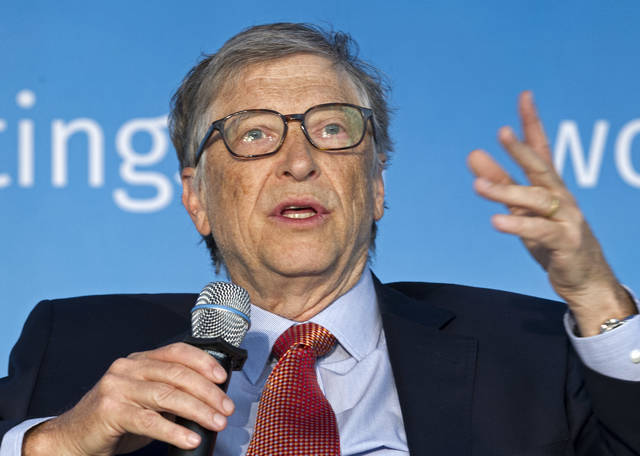SEATTLE — Marking another phase in his education agenda, Bill Gates is now taking a more targeted approach to help struggling U.S. schools.
The Bill and Melinda Gates Foundation is now funding groups working directly with clusters of public schools in some of the most impoverished regions of the country. Many of those third-party groups already had relationships with the world’s largest philanthropy, and some of the grants went straight to a school district and charter schools organization.
The foundation on Tuesday announced the first round of nearly $100 million for 19 program initiatives for middle and high schools in poor communities across 13 states. Gates pledged $460 million over the next five years to fund networks of school programs that help low-income and minority students get to college.
The grants will address the whole scope of what it takes to get those students to college — from academic skills like math and english proficiency, to existential pitfalls like middle school suspensions and the college application process.
It’s also another indication that the Microsoft co-founder is trying to be less prescriptive with top-down ideas that have rankled some educators. Critics have said the foundation’s work over the past decade has included trial-and-error programs that haven’t accomplished as much as hoped to help vulnerable children succeed in school.
“We’re not inventing anything in this strategy. We’re taking what we learned from research and experience,” said Bob Hughes, who leads Gates’ K-12 education program.
Letting local and regional forces take the lead marks a departure from the national or system-wide education initiatives that Gates previously supported, including majorly consequential directives over academic standards, teacher evaluations and school sizes.
Here’s a look at some of the Gates Foundation’s educational funding over the past two decades:
NETWORKS FOR SCHOOL IMPROVEMENT
SINCE 2018 ’ $460 Million
Gates is granting money for specific proposals submitted by various groups, public school districts and charter school networks to support and expand programming ideas aimed at helping low-income children.
Among the grantees is the San Diego-based High Tech High Graduate School of Education. The program’s provost Ben Daley said the school will use the money to help students navigate what can be an overwhelming college admissions process that includes trying to get financial aid, transferring credits and following up on college acceptance letters.
Daley said that work will be more nuanced than just layering more programming on top of what’s already offered, so that it can be a “simple, engaging and positive” resource for kids across 30 public, charter and alternative high schools in his region.
“We know if it’s just like ‘more.’ That’s not going to work,” Daley said.
COLLEGE SCHOLARSHIPS
1999-2018 ’ $1.6 BILLION
The most enduring Gates Foundation program was the Gates Millennium Scholars.
Gates wanted to foster diversity in science-related fields with college scholarship money. More than half of the 20,000 scholarships went to lower-income minority students whose parents hadn’t gone to college. Gates also supported recipients when many went on to graduate school with hopes to diversify leadership in those fields.
That program officially ended in 2018, though the scholarship model lives on as the new Gates Scholars program, which is limited to undergraduate studies.
COMMON CORE
2008-2017 ’ $280 million
Gates used his money and celebrity to support the Common Core State Standards because he believed it ensured all kids got an equally good education. The academic standards determined what kids should learn, but doesn’t set the curriculum or determine how kids learn.
His success was evident when nearly all states initially adopted it, but President Barack Obama’s support became politically problematic.
Obama’s administration created incentives benefiting Common Core’s roll-out, which critics slammed as tantamount to federal overreach. The teachers and parents who also soured on the standards claimed a formulaic approach to education was confusing and detrimental to the learning process.
TEACHER QUALITY AND EVALUATIONS
2009-2015 ’ $257 Million
Gates set out to quantify what it takes to be a good teacher and partially funded school districts that were piloting ways to measure and improve teaching. But the idea to tie student test scores to teacher evaluations upset some teachers.
The program ended poorly. An independent Rand Corporation report commissioned by Gates said the endeavor failed to substantially improve the learning process for either teachers or students. Hillsborough County Public Schools in Tampa, Florida was left scrambling financially after the Gates money disappeared.
SMALL SCHOOLS
2001-2009 ’ $345 million
Convinced that smaller schools with specific interests could foster better, more motivated learning for the most at-risk students, Gates spent millions testing how to break up the large comprehensive high school model.
But schools struggled with the logistics of multiple academies under the same roof and communities felt disconnected by the changes. The academic gains were in some cases impressive but limited in scope. Gates chalked it up to the financial and political cost of changing traditional schools.
LIBRARY TECHNOLOGY
1999-2007 ’ $325 million
Bill and Melinda Gates’ first major charitable effort was to install personal computers and internet access in libraries. Then known as the Gates Library Foundation, the initiative was eventually absorbed into their namesake, Seattle-based foundation that is today the world’s largest private nonprofit.
The man who led the computing revolution and his wife — a former computer programmer and Microsoft manager — gave money for computers, internet and librarian training.
The library program ensured 10,000 libraries — or 99 percent of all public libraries at the time — across the country had access to the new technology, particularly in low-income communities.
———
Follow AP Education Reporter Sally Ho on Twitter: https://twitter.com/—SallyHo


